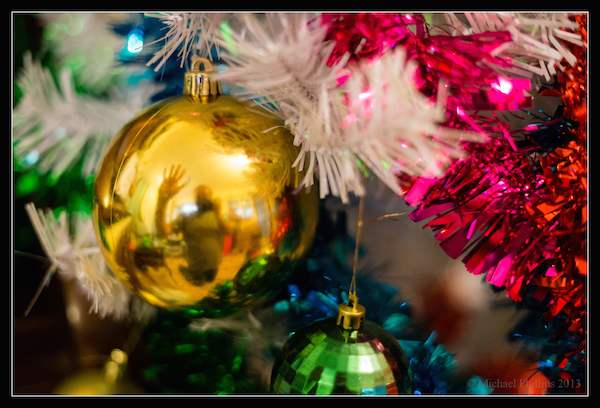
Credit: Michael; Flickr CC BY-NC-ND 2.0
If you celebrate Christmas, there’s a good chance you celebrate with a Christmas tree—79% of American households are expected to display a festive tree this holiday season, according to the American Christmas Tree Association.
The rich history of bringing the great outdoors to your great room dates back to 16th century Germany, so there have been more than a few holiday seasons for the Christmas tree to become tradition. Because when you think about it, it’s a strange custom—we scour the forest to find the best looking evergreen, kill it, drag it inside our homes, and then feebly try to keep it alive for a few weeks (during which time it instead slowly dies and scatters its needles all across our floor).
But we do it, and then we decorate it. One of the oldest forms of tree décor, which was designed to reflect the festive lights draped across the boughs, still persists today—tinsel. The sparkly arboreal accessory even has a materials science history that hops all around the Periodic Table.
Watch C&EN Online’s video below to get the full tinsel-covered scoop.
Credit: CEN Online; YouTube
Whether you decorate the Christmas tree with tinsel or not, however, there’s perhaps a more debated question looming—real or artificial?
According to the National Christmas Tree Association, Americans purchased more than 33 million real trees—85% of which were pre-cut—in 2013, compared to less than 15 million artificial trees. But those figures don’t account for households that already owned an artificial tree, which has an average lifespan of six to nine years.
Although some argue that real trees are more environmentally responsible, and others contend that artificial trees cost less, which is really better? I decided to break it down in classic fashion—a pros and cons list. Here goes:
Artificial
Pros
1. Lasts for several years
2. Doesn’t kill innocent trees
3. Cheap and easy—prelit trees, yes please!
Cons
1. Contains chemicals like PVC, which have negative environmental and health effects
2. Has a rather large carbon footprint for manufacturing and export
3. Once you throw it away, it sits in a landfill for a long time
4. Doesn’t smell Christmas-y
5. Drops plastic needles all over your floor that you’ll still be cleaning up next Christmas
Real
Pros
1. While growing, provides a habitat for other organisms and helps remove CO2/add O2 to the atmosphere
2. Pine fresh scent
3. All natural
4. Can be recycled or reused (as firewood, mulch, etc.)
5. Supports local farmers
Cons
1. One and done (or is that a pro?)
2. Farmers use pesticides while growing them (although the amounts used are low compared to other plants)
3. Not so cheap and easy—must be foraged and manually decorated
4. Wastes natural resources, unless it’s recycled and reused
5. Drops real needles all over your floor that you’ll still be cleaning up next Christmas
The official tally puts phloem and xylem ahead of plastic. But the final word on what goes down in your household comes to personal preference and what you care most about—your wallet, your time, or the well-being of the planet.
According to a Mother Jones article, if the planet reigns supreme, the best option is a potted live Christmas tree that can then be planted after the holidays. Need another option? Get creative, forgo the traditional, and use recycled materials—whether Mt. Dew cans, circuit boards, or forks—to build your own.
Talk to us: What do you think about Christmas trees—waste or tradition? And if they get a thumbs up, what’s your material of choice?
